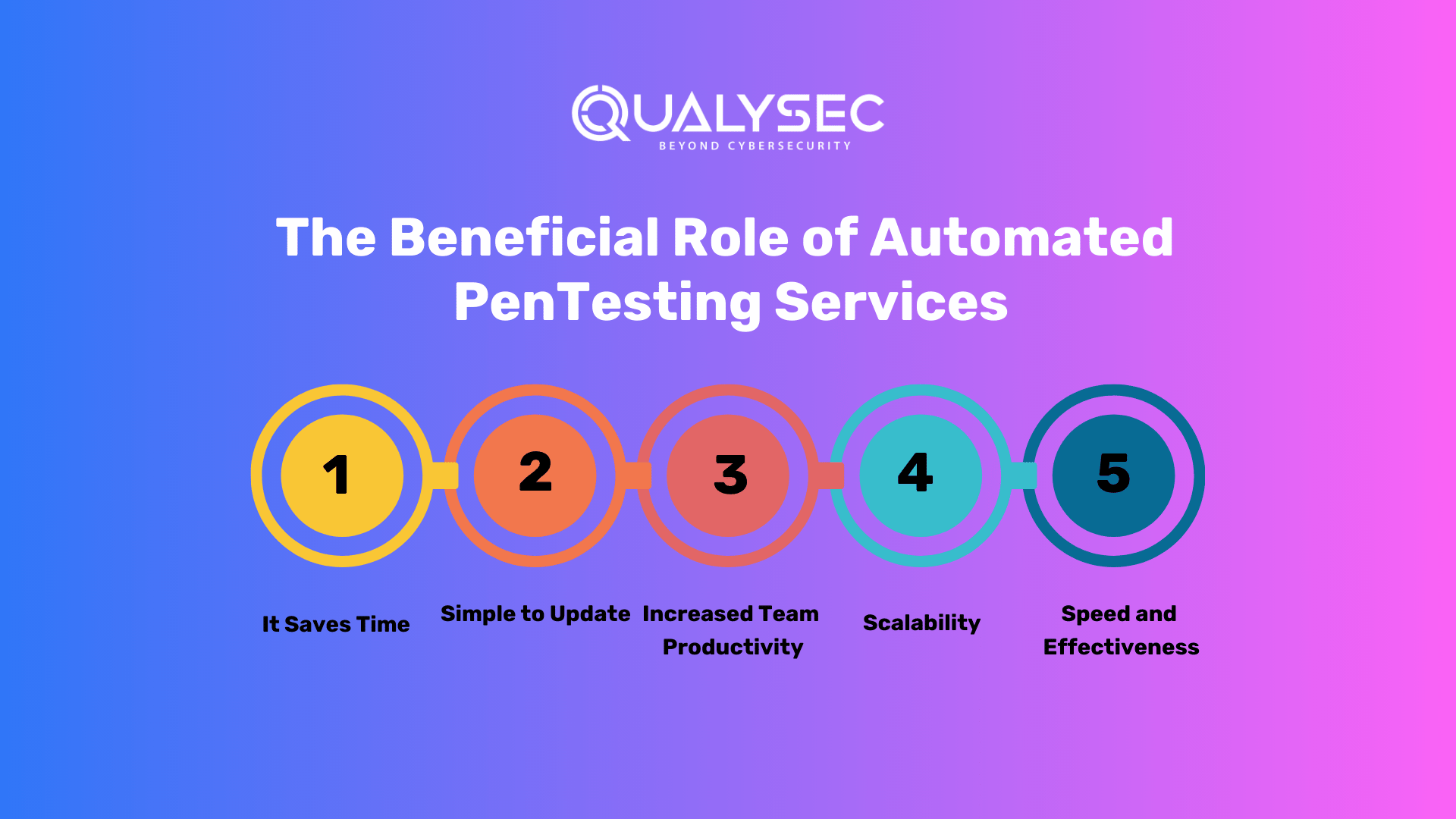The new digital environment is perilous. In today’s digital world, every organization is a target, and every firm, large or small, has operations, brand, reputation, and income pipelines that might be jeopardized by a breach. The focus should be on the cyber-attack and automated penetration testing to evaluate what and how to minimize risks and improve resiliency and recovery.
More than ever before, the digital world requires efficient penetration testing services and procedures that simulate attacks in real-time and can easily be updated to reflect newer attack strategies and vulnerabilities, thereby preventing real attacks. Manual, automated, or a combination of both methods can be used for penetration testing.
In this blog, we’ll look at automated penetration testing, its advantages, and its effectiveness in guarding against cyber-attacks and vulnerabilities.
The Growing Importance of Cybersecurity Today
Vulnerability assessment (VA) is a critical procedure for organizations that seek to find and analyze high-risk vulnerabilities in their attack surface before attackers can exploit them. Check out the following statistics to discover how other firms are doing and what ambitions their cybersecurity colleagues have in this area:
- The VA market will increase at a 10% CAGR (Compound Annual Growth Rate) during the next five years.
- One in every five firms does not test their software for security flaws.
- 70% of firms have a vulnerability assessment tool, either in-house or as a third-party service.
- For proactive security measures, 70% of respondents purchased a vulnerability assessment tool.
- To eliminate false-positive alarms, 52% of them wish to switch to a new assessment app.
- Automation is used by 56% of responders to help with vulnerability management. According to 47% of them, prioritizing is automatic.
According to a 2022 Vulnerability Management Report, when evaluating solutions, cybersecurity professionals prioritized vulnerability assessment (70%) over asset discovery (66%), vulnerability scanning (63%), and risk management features (61%).
The Rise of Automation on Security Penetration Testing
The emergence of automation in penetration testing is a watershed moment in the cybersecurity world, ushering in a new era of efficiency and accuracy. As enterprises face more complex cyber-attacks, automation emerges as a powerful ally, allowing for the quick discovery and correction of vulnerabilities.
Advanced algorithms and machine learning are used in automated penetration testing applications to simulate real-world cyber assaults, delivering a full assessment of an organization’s security posture. This advancement speeds up testing and improves the scalability of security measures, allowing for more frequent and complete inspections.
The use of automation, however, does not lessen the importance of human knowledge; rather, it frees up cybersecurity specialists to focus on strategic analysis, threat intelligence, and the creation of specialized solutions. The symbiotic link between automation and human intelligence strengthens enterprises’ resilience in the face of emerging cyber threats, guaranteeing proactive and adaptive protection in an increasingly digital environment.
What is Automated Penetration Testing?
Automated pentesting (also known as vulnerability scanning) is the practice of assessing security hazards in an application using automated security tools. Automated pentesting and security audits are significantly faster than human penetration testing, which takes a lot of personnel and money.
You may anticipate automated testing to produce results in a matter of seconds to a few minutes. Scanning for vulnerabilities, attempting to exploit them, and creating thorough reports on the results are all part of the job.
How Does it Work?
Organizations may save substantial time and costs by replacing manual efforts with automated software solutions while still maintaining strong security testing. Typically, automated testing entails the following steps:
- Vulnerability Assessment: The tool then runs automated tests to detect flaws such as weak passwords, obsolete software, or misconfigured servers.
- Exploitation: If a vulnerability is discovered, the tester will attempt to exploit it to obtain access to the application or network.
- Reporting: The tester creates a report that includes the vulnerabilities discovered as well as repair suggestions.
Automated penetration testing may be beneficial for enterprises to examine their security posture since it identifies possible security problems quickly and efficiently.
Also Read: What is the Workflow of Penetration Testing
NB– It is crucial to note, however, that automated tools are not a replacement for manual testing and may not uncover all vulnerabilities.
Want a brief workflow of penetration testing services? Schedule a call with our expert Security Consultants today! With years of experience and expertise, you’ll get great insight into how the pentest works.
Talk to our Cybersecurity Expert to discuss your specific needs and how we can help your business.
The Difference Between Manual and Automated Penetration Testing
This table provides a concise overview of the key distinctions between automated and manual penetration testing, helping organizations understand the strengths and limitations of each approach in their cybersecurity strategies.
| Aspect | Automated Penetration Testing | Manual Penetration Testing |
| Nature of Testing | Automated testing relies on pre-programmed tools and scripts. | Manual testing involves human testers who actively mimic real-world hacking scenarios. |
| Scope | Suitable for large-scale and repetitive tasks. | Ideal for complex, targeted, and scenario-specific assessments. |
| Speed | Faster execution due to the ability to scan large networks and applications. | Slower in comparison due to the thorough, hands-on approach. |
| Accuracy | Prone to false positives and false negatives. Requires periodic human validation. | High accuracy as human testers can adapt, improvise, and identify nuanced vulnerabilities. |
| Adaptability | Limited adaptability to evolving threats without regular updates. | Highly adaptable to emerging threats and evolving security landscapes. |
| Human Intuition | Lacks human intuition, creativity, and the ability to understand context. | Relies on human intuition, experience, and contextual understanding. |
| Depth of Analysis | Surface-level scanning may miss complex vulnerabilities. | In-depth analysis, uncovering complex and subtle security issues. |
| Scalability | Highly scalable for testing large and diverse applications. | Less scalable, particularly for extensive or time-sensitive assessments. |
| Customization | Limited customization options beyond predefined scripts. | Highly customizable to suit specific organizational needs and unique environments. |
| Tool Dependency | Dependent on the effectiveness of automated testing tools. | Not heavily reliant on tools; testers can choose the most suitable methods for each scenario. |
| Threat Simulation | Limited in simulating complex, realistic threat scenarios. | Can mimic sophisticated attack scenarios, providing a more realistic assessment. |
Also Read: Security Testing vs Penetration Testing
The Beneficial Role of Automated Pen Testing Services
A tester or business can benefit greatly from the best automated penetration testing tools. Below are a few examples:

1. It Saves Time
Timing is still one of the reasons in favor of automated testing; in fact, it is a fact. Automated tools significantly minimize the time required for penetration testing. Similarly, reports are generated practically immediately once a test is done. Manual testing can do this; in certain circumstances, a compilation of findings might take several days to weeks.
2. Simple to Update
Many automated programs may be simply updated to reflect modern pen-testing methodologies and detect newer intrusion types. This is accomplished via an OTA update provided by the developers or by downloading update scripts. A human tester may require more time to become acquainted with current information in the pen testing sector.
3. Increased Team Productivity
Auto-testing technologies automate the time-consuming and repetitive operations of vulnerability scanning, target identification, and privilege escalation. As a consequence, developers and security team members experience less stress and increased productivity since they can focus their efforts on advanced security measures or other jobs that need human participation.
4. Scalability
As businesses develop, so do their networks and applications, making it increasingly difficult for human specialists to stay up. Automated penetration testing provides a scalable approach that can be quickly implemented throughout an increasing organization’s infrastructure, enabling ongoing security testing for known vulnerability patterns.
5. Speed and Effectiveness
The ability of automated security testing solutions to swiftly uncover security flaws across a wide range of applications is one of its primary selling advantages. Organizations may scan their networks and apps using automated technologies in a fraction of the time it would take a human pentester to do the same operations.
NB– While it is true that speed is an advantage of automated tools, it is vital to note that employing automation without knowing how to utilize it effectively can result in service outages and a lot of useless noise in monitoring applications.
Also Read: The Impact of VAPT on Business Success
What are the Best Automated Penetration Testing Tools Used in Penetration Testing?
Here are the 5 best tools you should know about used in automation security testing:
- Metasploit: A popular tool for automated penetration testing. Provides a wide range of exploits, payloads, and auxiliary modules. A complete approach for penetration testing and vulnerability assessment is provided.
- Burp Suite: A web application security testing tool. Crawling, scanning, and different tools for detecting and exploiting vulnerabilities are available. Security professionals frequently use it for automated web application testing.
- OWASP: An open-source tool for detecting flaws in web applications. Includes automatic scanners and a variety of tools for manual and automated testing. The Open Web Application Security Project (OWASP) community keeps it up to date.
- Nessus: A popular vulnerability scanner. Offers automatic scanning for a variety of networks and applications. Provides a complete collection of functionalities for detecting and mitigating vulnerabilities.
- Nmap: This program is mostly used for network discovery and security audits. Provides a variety of capabilities, such as port scanning and version detection. Widely used in penetration testing to automate network exploration.
Note: While automated penetration testing techniques are strong and fast, leading organizations frequently supplement automated testing with manual penetration testing to achieve more thorough findings. Manual testing offers a more in-depth understanding of the context, the capacity to recreate complicated attack scenarios, and the detection of small vulnerabilities that automated methods may overlook.
A cybersecurity approach that combines automated and manual testing is more resilient and effective. This balanced approach allows firms to utilize automation’s capabilities while benefiting from human testers’ insight, inventiveness, and flexibility.
What Best Practices Should You Follow for Automated Penetration Testing?
Security tests are usually performed after a product has been delivered, but waiting so long might allow testers to overlook authentication vulnerabilities and other internal security weaknesses. DevSecOps is a methodology that incorporates security checks at various stages of the development and testing process to discover potential security vulnerabilities. The recommended approaches for establishing automated security testing are summarized here:
1. Create a Testing Strategy
Begin by outlining the policy’s scope. Examine any networks, apps, or programs that must be subjected to security testing. Consider any applicable industry rules or security standards, such as GDPR, ISO 27001, PCI DSS, HIPAA, OSWAP, and so on. If a hacker takes advantage of a weakness and obtains access to those customers’ data, your company might face fines and penalties.
2. Conduct Security Scans
Security scans are automated security processes that look for known misconfigurations and vulnerabilities in programs. Security scans include the following:
- Network scanning: Examines the network infrastructure for problems such as open ports, entry points, and services.
- Web application scanning: Detects vulnerabilities that are common in web applications. They investigate well-known issues like as input fields, session management, and authentication applications.
- Wireless network scanning: Looks for flaws in the security that protect wireless networks, such as insufficient encryption or rogue devices.
3. Perform Security Audits
Security audits assess a company’s security procedures, policies, and controls. They are utilized to conduct a thorough examination of all security measures. The purpose is to evaluate the efficacy of your security posture and find any holes. Here are some instances of audits performed with security automation tools:
- Compliance: Compliance audits examine how effectively a firm complies with specified security standards or regulatory obligations.
- Configuration Audits: Examine an organization’s application settings against security best practices.
- Policy and Procedure Audits: Examine the efficacy of a company’s security processes and policies. Examining policy documents and implementation strategies is part of the review process.
4. Improve Security with VAPT
Vulnerability scans detect flaws in your applications, networks, and software applications before bad actors exploit them. To eliminate false positives and ignore weak points, employ high-quality security testing tools in conjunction with a trusted vulnerability scanner.
Penetration testing goes beyond vulnerability scanning to assess the security of your company’s infrastructure by employing actual assaults. They assist you in determining your effectiveness in enhancing your organization’s security posture. When serious flaws are identified, you may prioritize remedial activities and improve overall security.
5. Create a Safe Data Handling Process
Begin by categorizing the data utilized for security testing. Look for and distinguish between data such as personally identifiable information (PII) and anonymized data. Replace genuine customer data with jumbled or made-up data that keeps the format but does not reveal personal information. By using synthetic data, the risk of disclosing genuine data during testing is eliminated. Use rigorous access restrictions to prevent people from obtaining information utilized during testing and avoid utilizing unprotected channels or public networks that might be captured.
But, Is Automated Pentesting Enough for Your IT Infrastructure?
While automated penetration testing is important in analyzing the security posture of IT infrastructure, it is critical to realize its inherent limits. The danger of false positives and negatives is a big disadvantage, since automated methods may lack the sophisticated understanding and contextual analysis that human testers bring to the table.
Automated testing frequently focuses on known vulnerabilities, possibly disregarding unique or customized attacks that may be more difficult to detect. Furthermore, the rigidity of automated tools may make it difficult to react to emerging attack routes, exposing holes in security protection.
While these technologies excel at quickly scanning big networks, they may only give a surface-level analysis, ignoring sophisticated vulnerabilities that need a more in-depth review. Another factor to consider is automation testing’s incapacity to imitate the inventiveness and intuition of human hackers, limiting its ability to identify small flaws that exploit in real-world circumstances.
As a result, prominent businesses recognize that relying entirely on automated penetration testing may create a false feeling of security. Organizations frequently supplement automated tests with manual penetration testing to establish a thorough and robust cybersecurity plan.
This hybrid method leverages automation’s efficiency while benefiting from human testers’ skill, adaptability, and inventiveness, eventually bolstering IT infrastructure’s overall security posture against a larger range of cyber threats. The testers create a report post the testing performed to give insights into what vulnerabilities were discovered.
If you want to learn more about this pentest report and get insights on how testers help you refine your applications. Here’s a downloadable sample report.
Latest Penetration Testing Report

How Can Qualysec Help You Identify Vulnerabilities Better?
Qualysec Technologies is a pioneering process-based penetration testing services provider, that effortlessly merges manual experience with cutting-edge automation to give unrivaled results in finding vulnerabilities and protecting your IT infrastructure. Our technique is unique in combining the precision of automated penetration testing tools with the knowledge, creativity, and flexibility of human testers, resulting in a complete study that goes beyond the constraints of purely automated methods.
What distinguishes Qualysec is our focus on offering a complete, developer-friendly path to improve your organization’s security posture rather than just a report. Our penetration testing reports are customizable to suit regulatory and industry standards such as PCI DSS, HIPAA, ISO 27001, and others. We recognize the crucial importance of a strong security architecture, and our careful procedure guarantees that your applications are protected against both known and developing threats.
Choosing Qualysec means selecting a partner who commits to the security and compliance of your IT infrastructure. Our professionals equip the most up-to-date technologies and procedures, ensuring your firm keeps one step ahead of possible cyber threats. Qualysec takes cybersecurity to the next level, combining innovation, accuracy, and human intelligence to protect your digital assets.
Conclusion
We’ve decoded the definition of automated penetration testing, unraveled the complexities of its implementation, and shed light on the critical contrasts between human and automated procedures. We’ve put out a collection of the finest automation testing tools meant to simplify security audits.
These technologies, when mentioned strategically, guarantee not just a rapid and easy penetration test, but also a nuanced discovery of weaknesses critical to reinforcing your digital fortress. As a result, the call to action rings true: choose carefully now.
Improve your security posture by combining automation and precision technologies to protect your digital environment in an ever-changing cyber domain. Contact us today!
FAQs
What is Automated penetration testing?
The technique of analyzing security risks in an application using automated security tools is known as automated pentesting. Automated pentesting and security audits are far faster than human penetration testing, which takes a substantial amount of time and money.
What is the difference between Automated penetration testing and manual penetration testing?
Because everything is done manually in a manual pentest exercise, the testing team checks their results throughout the process; each step is documented and double-checked. This openness is not accessible in automated testing, and the findings might be difficult to verify.
How do I decide whether to choose automated or manual penetration testing for my business?
Consider the nature of your business, the criticality of your applications, and the compliance standards you must satisfy. Automated testing can be useful for routine tests and speedy discovery of common vulnerabilities. However, adding manual testing enables a more complete and targeted security review if your company works with sensitive data, complicated applications, or compliance demands. Choose an automated pen testing service provider that offers a hybrid approach that combines both automated and manual testing frequently hits the appropriate mix, using the benefits of both for a complete cybersecurity plan customized to your business’s needs.
What are the three 3 types of penetration tests?
Penetration testing technique is divided into three types: black-box testing, white-box testing, and gray-box testing.
































































































































































































































































































































































































































































































































0 Comments